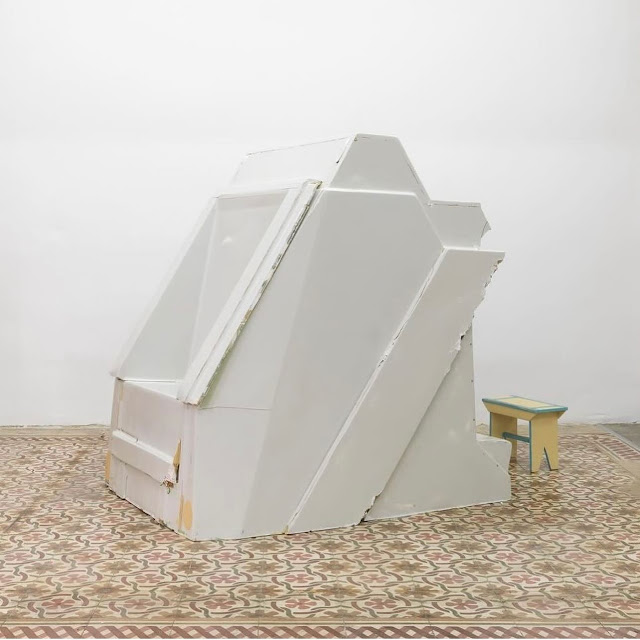Still from One Week, 1920. Courtesy Park Circus
In 1920, Buster Keaton released his first solo film, One Week, at around the same time as Duchamp was working on The Large Glass (The Bride Stripped Bare by her Batchelors, Even). One Week uses beautifully executed visual jokes to tell the story of a man’s doomed attempts to build a flat-pack house—the utopian modernist readymade—for his bride. Keaton not only performed his own stunts; he also designed the mechanics by which the scenes were created, along the way inventing shots and editing sequences that have now become the accepted syntax of cinema. Viewed shot by shot, these scenes undermine certainties about the world we inhabit and represent the inevitability of failure when we try to exert control.
Curated by Simon Faithfull and Ben Roberts, The World Turned Upside Down, places the work of over twenty international artists working in film, sculpture, installation art and performance in direct relation to Buster Keaton’s films to track a lineage from the melancholic and at times anarchic comedy of Keaton to the dry wit of conceptual practice. By examining Keaton’s approach to art through making—the processes of repetition, failure and risk—the exhibition also establishes a nuanced presentation of the developmental relationship between slapstick film, sculpture and performance and highlights parallels within modern and contemporary sculptural practice which continue to resonate today.
The exhibition features work of conceptual artists working in film, photography, sculpture, installation art and performance; by historical and contemporary, established and emerging artists. These include Bas Jan Ader, Marcel Broodthaers, Alexandre da Cunha, Simon Faithfull, Fischli Weiss, Brian Griffiths, Emma Hart, Jeppe Hein, Sofia Hultén, Tehching Hsieh, Gordon Matta-Clark, Hayley Newman, Miranda Pennell, Ruth Proctor, Roman Signer, William Wegman, Richard Wentworth, Richard Wilson, John Wood and Paul Harrison, Ben Woodeson and Erwin Wurm. The associated events programme features performances by Angus Braithwaite, Andy Holden, Jefford Horrigan, Ruth Proctor and William Hunt.
The World Turned Upside Down places the work of these artists in direct relation to three of Keaton’s early films: The Boat, The Cameraman and One Week, which will be continuously played throughout the exhibition. Through the plotting of these connections, the exhibition establishes a nuanced presentation of slapstick and the developmental relationship between sculpture and performance.
The World Turned Upside Down is a Mead Gallery exhibition which has been supported by The Henry Moore Foundation.
Warwick Arts Centre
University of Warwick
Coventry CV4 7AL
www.meadgallery.co.uk
Alongside the exhibition there are a number of events running throughout the season. Events include:
Exhibition tours
Join Fiona Venables, Assistant Curator, for a 30-minute introduction to The World Turned Upside Down. The exhibition tours are free but places are limited so please book ahead by calling the Box Office.
Fail Better – Deconstructing Buster Keaton
Warwick Arts Centre hosts a packed two days of artists’ performances, film screenings and talks to coincide with The World Turned Upside Down. Contributors include Angus Braithwaite, Simon Faithfull, Andy Holden, Jefford Horrigan, William Hunt and Ruth Proctor.













